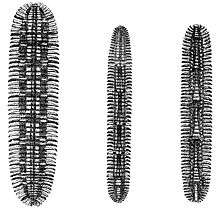Platydesmida
| Platydesmida | |
|---|---|
_millipede_(3680001399).jpg) | |
| Brachycybe lecontii (Androganthidae), a species found in eastern North America. | |
| Scientific classification | |
| Kingdom: | Animalia |
| Phylum: | Arthropoda |
| Class: | Diplopoda |
| Subclass: | Chilognatha |
| Infraclass: | Helminthomorpha |
| Order: | Platydesmida Cook, 1895 |
| Families | |
|
Andrognathidae | |
Platydesmida (Greek for platy "flat" and desmos "bond") is an order of millipedes containing two families and over 60 species.[1] Some species practice paternal care, in which males guard the eggs.
Description
Platydesmidans have a flattened body shape with lateral extensions (paranota) on each segment. They lack eyes, and have between 30 and 110 body segments. They measure up to 60 mm (2.4 in) in length.[2]
Behavior
While most millipedes feed on dead or decomposing leaf litter platydesmidans may be specialized to feed on fungi. Platydesmidans have also been studied with regard to parental investment, in that males of some species coil around eggs and young, a rare example of paternal care in arthropods. This behavior has been observed in species of Brachycybe from North America and Japan, and Bazillozonium and Yamasinaium from Japan, all are in the family Andrognathidae.[3][4]
Distribution
Platydesmidans occur in North America, Central America, the Mediterranean region of Europe, Japan, China, southeast Asia and Indonesia.[5]
Classification



The order contains two families.[6]
Family Andrognathidae Cope, 1869
- Andrognathus
- Bazillozonium
- Brachycybe
- Corcyrozonium
- Dolistenus
- Fioria
- Gosodesmus
- Ischnocybe
- Mitocybe
- Pseudodesmus
- Sumatronium
- Symphyopleurium
- Trichozonium
- Yamasinaium
- Zinaceps
- Zinazonium
Family Platydesmidae DeSaussure, 1860
- Desmethus
- Platydesmus
References
- ↑ Shear, W. (2011). "Class Diplopoda de Blainville in Gervais, 1844. In: Zhang, Z.-Q. (Ed.) Animal biodiversity: An outline of higher-level classification and survey of taxonomic richness" (PDF). Zootaxa 3148: 159–164.
- ↑ "Diagnostic features of Millipede Orders" (PDF). Milli-PEET Identification Tables. The Field Museum, Chicago. Retrieved 25 October 2013.
- ↑ KUDO, Shin-ichi; KOSHIO, Chiharu; TANABE, Tsutomu (2009). "Male egg-brooding in the millipede Yamasinaium noduligerum (Diplopoda: Andrognathidae)". Entomological Science 12 (3): 346–347. doi:10.1111/j.1479-8298.2009.00331.x.
- ↑ Kudo, Shin-Ichi; Akagi, Yoshinobu; Hiraoka, Shuichiro; Tanabe, Tsutomu; Morimoto, Gen (2011). "Exclusive Male Egg Care and Determinants of Brooding Success in a Millipede". Ethology 117 (1): 19–27. doi:10.1111/j.1439-0310.2010.01851.x.
- ↑ Shelley, Rowland M. (1999). "Centipedes and Millipedes with Emphasis on North American Fauna". The Kansas School Naturalist 45 (3): 1–16.
- ↑ http://www.catalogueoflife.org/col/browse/tree/id/17063536
Further reading
- Costa, James T. (2006). "Other Social Arthropds: Arachnids, Centipedes, Millipedes, and Crustaceans". The Other Insect Societies. Cambridge, Mass.: Belknap Press of Harvard University Press. pp. 667–716. ISBN 9780674021631.
External links
 Media related to Platydesmida at Wikimedia Commons
Media related to Platydesmida at Wikimedia Commons Data related to Platydesmida at Wikispecies
Data related to Platydesmida at Wikispecies- Platydesmida at the Encyclopedia of Life
| ||||||||||||||||||||||||||||||||||||||||||||||||||||||||||||||||||||||||||||||||||||||||||||||||||